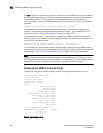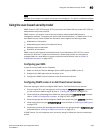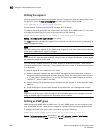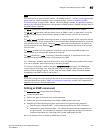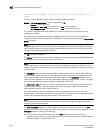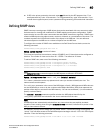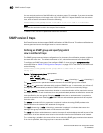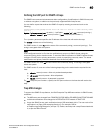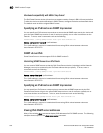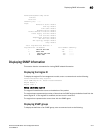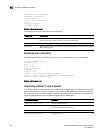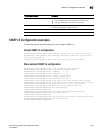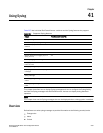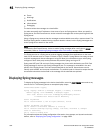
PowerConnect B-Series FCX Configuration Guide 1375
53-1002266-01
SNMP version 3 traps
40
Defining the UDP port for SNMP v3 traps
The SNMP host command enhancements allow configuration of notifications in SMIv2 format, with
or without encryption, in addition to the previously supported SMIv1 trap format.
You can define a port that receives the SNMP v3 traps by entering a command such as the
following.
PowerConnect(config)#snmp-server host 192.168.4.11 version v3 auth security-name
port 4/1
Syntax: [no] snmp-server host <ip-addr> | <ipv6-addr> version [ v1 | v2c <community-string> |
v3 auth | noauth | priv <security-name>] [port <trap-UDP-port-number>]
The <ip-addr> parameter specifies the IP address of the host that will receive the trap.
For version, indicate one of the following
For SNMP version 1, enter v1 and the name of the community string (<community-string>). This
string is encrypted within the system.
NOTE
If the configured version is v2c, then the notification is sent out in SMIv2 format, using the
community string, but in cleartext mode. To send the SMIv2 notification in SNMPv3 packet format,
configure v3 with auth or privacy parameters, or both, by specifying a security name. The actual
authorization and privacy values are obtained from the security name.
For SNMP version 2c, enter v2 and the name of the community string. This string is encrypted
within the system.
For SNMP version 3, enter one of the following depending on the authorization required for the
host:
• v3 auth <security-name>: Allow only authenticated packets.
• v3 no auth <security-name>: Allow all packets.
• v3 priv <security-name>: A password is required
For port <trap-UDP-port-number>, specify the UDP port number on the host that will receive the
trap.
Trap MIB changes
To support the SNMP V3 trap feature, the Dell Enterprise Trap MIB was rewritten in SMIv2 format,
as follows:
• The MIB name was changed from FOUNDRY-SN-TRAP-MIB to FOUNDRY-SN-NOTIFICATION-MIB
• Individual notifications were changed to NOTIFICATION-TYPE instead of TRAP-TYPE.
• As per the SMIv2 format, each notification has an OID associated with it. The root node of the
notification is snTraps (OID enterprise.foundry.0). For example, OID for
snTrapRunningConfigChanged is {snTraps.73}. Earlier, each trap had a trap ID associated with
it, as per the SMIv1 format.




